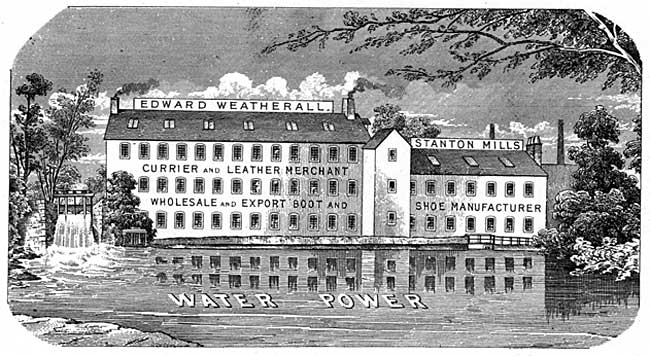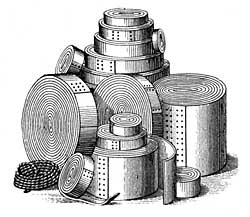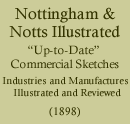< Previous | Contents | Next >
Stage by stage we watch the process, from the making of the outline or key-form on gelatine films to the drawing of each separate colour on separate stones, with specially prepared ink, and which number frequently from thirteen to sixteen, each colour being termed a "printing," from the fact that each must be drawn and printed separately.
And here, also, in order to keep well in line with the demands and requirements for dispatch of execution, all the most modern systems and appliances are daily and hourly invoked to assist, including photography, photo-lithography, and rapid shading mediums.
Taking a farewell of the artists, we approach another set of important craftsmen, viz., the proofers. It is here that the work is taken from the artists' hands, and by skilled and careful chemical treatment it is developed and rendered permanent, and fit to pass on again to the transferers and machine printers.
We are next conducted to the tin receiving room, where the large sheets of tin are brought from the railway in strong elm cases, weighing on an average 2 cwt. each. These are opened and the tin carefully examined, which is then cut to the required size. We follow the tin as it is taken to the huge printing room, 220ft. long, and which is fitted with every modern appliance, and is a model of neatness and order. When the requisite number of colours has been printed the sheets are passed along to the next department, that of varnishing and stoving, and in this department the utmost care is required, and none but thoroughly experienced hands are employed, as too long or insufficient stoving would entirely spoil the decoration.
Still another process, viz., that of polishing, is needed to complete the decorated sheets which are intended for high-class advertisements in the shape of tin tablets. Here every imperfection and dust mark is removed, and a superfine polish is produced equal to porcelain. When the decorated sheets have received this treatment, it may be said that they have passed through the first series of manufacture, and are now ready to be passed on to what is termed the "making department." This portion of the business occupies about one-half of the entire building. Here the decorated sheets are cut up to the various sized boxes and canisters required, the lids and bottoms are stamped out and the bodies of the tins are formed. Next the tops and bottoms are put on and all the processes completed, until we behold the finished article.
It would be impossible in the space at our disposal to describe the details of the "making " process. Sometimes as many as twenty to thirty distinct operations are required before the tin box is finally completed. To stand and look at one of these large rooms, filled with machinery, and the multitude of busy workers passing to and fro with tins in various stages of manufacture, is a sight almost baffling description, whilst the noise of the monstrous presses which are striking out the different shaped tins is like so many guns being fired, and if you closed your eyes you could well imagine that you were attending a practice of artillery.
When the various boxes and canisters are completed they are passed on to the packing room where each one is examined. They are then packed in parcels and finally put into large wooden cases and sent to their respective destinations. We noticed a large quantity of tins were being sent by the firm to New Zealand, whilst another large consignment of show tablets were intended for shipment to India.
The whole of this extensive works is fitted with electric light, and so extensive is the installation that the firm employ their own electrical engineer to superintend and keep this in thorough repair.
Bidding adieu to the Mansfield Works, we travel by Midland Railway a distance of 2½ miles to Sutton-in-Ashfield, in order to visit Oddicroft Works, which were purchased by the firm several years ago. This extensive factory is built on the weaving shed principle and is practically a duplicate of the Mansfield Works, with the exception that all the departments are on one level instead of being divided in separate buildings, as in the latter factory. The firm have also purchased nine acres of land adjoining these works with a view to further extensions. The building is on a most eligible site for commercial purposes, the Midland Railway joining on the north side, while the Great Northern Railway forms the boundary on the south. One of the chief features of importance in these works is the magnificent horizontal engine of 300 horse power, which was built by an eminent firm of engineers.
The Sutton works are exclusively employed in the decoration and manufacture of round canisters, both ordinary and lever lids, the latter being one of the largest and most important departments in connection with the firm. We saw in the course of manufacture innumerable quantities of canisters intended for baking powder, health saline, table salt, lemonade powder, patent foods, golden syrup, confectionery, etc.
At the extreme end of the factory, apart from what may be termed the main portion, is a building specially erected for the manufacture of wooden packing cases used by the firm, and as fast as these are put together they are sent into the works to be filled with the various kinds of tins above mentioned.
The firm employ on an average about five hundred workpeople, and have also their own fire extinguishing appliances, and a separate fire brigade, formed of their own workpeople, at each works, so that every precaution is taken to guard against this destructive foe.
In conclusion, we may say that the reputation of the firm for high-class work has long since been established, and is known to every large consumer of decorated tins throughout the Kingdom.
EDWARD WEATHERALL,
Currier and Leather Merchant, Wholesale and Export Boot and Shoe Manufacturer, Stanton Works, Bath Vale, MANSFIELD.
Telegrams—"WEATHERALL, MANSFIELD." National Telephone, No. 1927.

SITUATED amid surroundings of the most delightfully rural aspect, suggestive rather of the peaceful bucolic pursuits of the agriculturalist than of the busy bustle of a large mechanical industry, the factory of Mr. Edward Weatherall will well repay a visit, from those interested in a flourishing local manufacture. Thanks to the courtesy of the proprietor, our representative was permitted facilities for an inspection of the factory and plant, of which we present the following description for acceptance by our readers. The business owes its inception and subsequent rapid development to the busy energy of its present head, who, some fourteen years ago, acquired it of Mr. Beardsall, and then carried on in Pelham Street, Mansfield. Here he remained until the increasing volume of his output rendered it essential to provide more commodious accommodation, and Stanton Mills, a large building in the locality, formerly used as a cotton mill, being void, Mr. Weatherall became the occupier on a lease from His Grace the Duke of Portland. The premises, situated in the romantic demesne, Bath Vale, shown in our illustration, were admirably suited to the purpose in view, and possessing exceptional advantages in unlimited water power were quickly organised and equipped, and the business transferred thereto at the latter end of 1895. The Stanton Mills consist of a lengthy range of three and four storey building fronting the large pool from which the water is drawn to drive the wheel which supplies motive force for the machinery. This water wheel, of huge dimensions, is a noteworthy feature of the arrangements being constructed on an automatic principle to regulate the flow of water according to the power required and the number of machines at work at any given time. The wheel moves at the apparently leisurely pace of from four to five revolutions per minute, but, by the aid of the ingenious mechanical contrivances attached, is capable of imparting a speed of 2,500, as required for driving the dynamo which supplies electric light to all parts of the building.

In following the various processes of manufacture in their order of sequence, we commence our tour of inspection, in what is termed the "Rough Stuff Room," situated on the second floor. In this department is fixed all the heavy machinery used in cutting out the soles, heels and middles an improved appliance seen in motion dealing with a whole hide at once, thus effecting a considerable saving of time and labour in this operation. Ascending to the next floor we enter the busiest of the departments, that in which the rivetters and finishers are engaged in. The processes of manufacture, the numbers of disconnected parts already cut out, and which are put together and rapidly turned out in the form of perfect boots and shoes, is little less than marvellous. It would be impossible in the limit of space at disposal to give more than a general outline of the many ingenious labour-saving machines and appliances by which the work is accomplished, and which by almost superhuman ingenuity have been devised to effect their various purposes, Among the more interesting features, are, however, the lasting machines, by which the operator with great despatch, connects the uppers to the innermost part of the sole, and by means of which one workman is enabled to turn out the almost incredible number of eighteen dozen pairs in art ordinary working day. Each operator of a lasting machine is attended by a team of about twenty men and youths, some of whom are engaged in affixing the outer sole, heeling, and passing thence to a succession of hands, who in turn perform the processes of trimming, smoothing, and polishing the articles into finished shape. After careful examination by a responsible foreman, through whose hands no fewer than 3,500 pairs of boots and shoes pass weekly, the goods are transferred to the packing room, where they are put up and finally prepared for the market. On the fourth floor is the clicking and sewing machine room, the former process referring to the cutting out of the uppers and their closing ready for handling below. In this department we examined a remarkable little invention known as the "Amazeen Skiver," a contrivance for tapering off the edges of the leather for the purpose of joining, the idea being of course to promote greater comfort to the wearer. Descending again to the ground floor we glance in at the packing room, where are ready for despatch large packages of goods, a number of which we noted were labelled for South Africa, where at Durban, Port Natal, the firm has a representative. Careful study of the requirements of the Colonials has led to the introduction of some special brands of boots principally "wood pegged," as distinguished from the ordinary brass rivets, and for the Afrikander market a favourite make is one with uppers reaching well over the ankles to protect the wearer from snake bites or attacks from venomous insects infesting those regions. It is always better to have expert opinion on subjects with which one is not intimately acquainted from a technical point of view, and we therefore consider it preferable to embody the following description given on the unimpeachable Leather Record:—
"In men's and boys' submitted to us a series of of Mansfield. Among these, hand-sewn navvy tight, double and of irreproachable quality material. A strong whole kip, straight cap, nailed with fitter piece and soles, and five rows of the bottom. Cheaper quali-forated caps. The workman of this gentleman's specialities, authority of The Shoe and strong goods we have had samples by Mr. E. Weatherall, a boot of special value was a tongued and of excellent cut, in upper and bottoming half-tight boot, with perforated nails round the edge of toe-of small nails up the middle ties of Derby tights with per-ship displayed in these nailed goods is of no mean order, particularly in the driving of the hobs, which is done with remarkable taste and regularity. This likewise applies to the boys' nailed boots, which, though low in price, yet appear to be able to afford almost everlasting wear. Especially is this true of a nailed boot, the toe of which is iron clad, it having a strong metal toe-protector, which, nailed as it is on the surface of the sole, is moulded to fit in the crease between the bottom and the upper, and then rises as a toe-protector over the upper. In plain rivetted walking boots some specimens were also included. We do not hesitate to commend these goods to the attention of the trade. Mr. Weatherall's trade mark, stamped on all his goods, is an 'Anvil' and the words 'Warranted Solid' in a ring."
A more recent development of the undertaking, furnishing yet another evidence of Mr. Weatherall's enterprise, is the opening up of departments of the currying, leather lace cutting and belt manufacturing trade, an experiment the results of which appear eminently satisfactory if judged by the orders already executed and on hand in this branch of the business.
Adjacent to the factory are several cosy little cottages with spacious and neatly kept gardens attached, which are occupied by employes, and in connection with the Works a sick and benefit club has been instituted to form a provident fund, of which Mr. Weatherall acts as honorary treasurer. The specialities of manufacture bear the following well-known brands : The "Heroic " boot, the "Sturdie," the "Stanton Pit Boot," the "Anvil" boot, "Warranted Solid," and another suggestively entitled "The Weather All." These goods, as their names imply, are in requisition for a class of wear that demands durability beyond elegance, and that they admirably serve this useful purpose is manifestly apparent in the fact that some 4,000 pairs of boots and shoes represents the total weekly output of this admirably-organised establishment.
![]()
